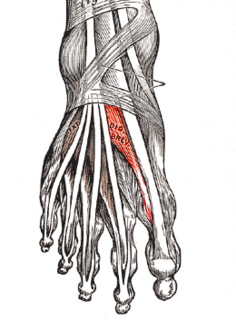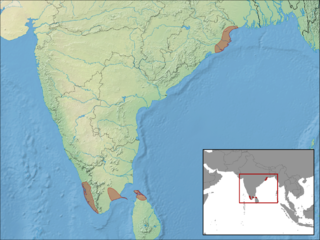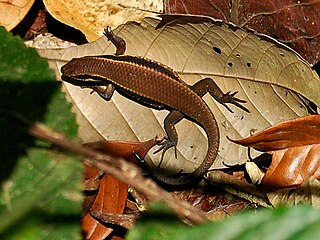| Eutropis brevis | |
|---|---|
| Scientific classification | |
| Kingdom: | Animalia |
| Phylum: | Chordata |
| Class: | Reptilia |
| Order: | Squamata |
| Family: | Scincidae |
| Genus: | Eutropis |
| Species: | E. brevis |
| Binomial name | |
| Eutropis brevis (Günther, 1875) | |
| Eutropis brevis | |
|---|---|
| Scientific classification | |
| Kingdom: | Animalia |
| Phylum: | Chordata |
| Class: | Reptilia |
| Order: | Squamata |
| Family: | Scincidae |
| Genus: | Eutropis |
| Species: | E. brevis |
| Binomial name | |
| Eutropis brevis (Günther, 1875) | |

The Eastern Ghats are a discontinuous range of mountains along India's eastern coast. The Eastern Ghats pass through Odisha, Andhra Pradesh to Tamil Nadu in the south passing some parts of Karnataka as well as Telangana. They are eroded and cut through by four major rivers of peninsular India, viz. Mahanadi, Godavari, Krishna, and Kaveri.

Pelorosaurus is a genus of titanosauriform sauropod dinosaur. Remains referred to Pelorosaurus date from the Early Cretaceous period, about 140-125 million years ago, and have been found in England and Portugal. Thomas Holtz estimated its length at 24 meters.

In human anatomy, the extensor pollicis brevis is a skeletal muscle on the dorsal side of the forearm. It lies on the medial side of, and is closely connected with, the abductor pollicis longus. The extensor pollicis brevis (EPB) belongs to the deep group of the posterior fascial compartment of the forearm.[1] It is a part of the lateral border of the anatomical snuffbox.

The extensor hallucis brevis is a muscle on the top of the foot that helps to extend the big toe.
Eutropis ashwamedhi, also known as the Ashwamedh writhing skink or Ashwamedha supple skink, is a species of skink found in India.

Eutropis bibronii, also known commonly as Bibron's mabuya, Bibron's skink, and the seashore skink, is a species of lizard in the family Scincidae. The species is native to India and Sri Lanka.

Eutropis clivicola, known as Inger's mabuya or mountain skink, is a species of skink found in India (Kerala). It was first formally described in 1984 as Mabuya clivicola.
Eutropis dawsoni, also known as Gans's mabuya and Gans's grass skink, is a species of skink, a lizard in the family Scincidae. The species is endemic to the southern Western Ghats, India.

The bronze grass skink, bronze mabuya or speckled forest skink, is a species of skink found in South and Southeast Asia. It is a common, but shy, ground-dwelling species that is active both day and night.

Eutropis multifasciata, commonly known as the East Indian brown mabuya, many-lined sun skink, many-striped skink, common sun skink or (ambiguously) as golden skink, is a species of skink.

The rough mabuya or brown mabuya is a species of skink. It is found in the Maritime Southeast Asia: Indonesia, Malaysia, Philippine Islands, Sulu Islands, as well as on the Nicobar islands of India.

Eutropis rugifera, variously known as Nicobar Island skink or rough-scaled sun skink, is a species of skink from southeastern Asia.

Missa brevis is Latin for "short Mass". The term usually refers to a mass composition that is short because part of the text of the Mass ordinary that is usually set to music in a full mass is left out, or because its execution time is relatively short.

The flexor digiti minimi brevis is a hypothenar muscle in the hand that flexes the little finger at the metacarpophalangeal joint. It lies lateral to the abductor digiti minimi when the hand is in anatomical position.

The Toyota Brevis is a former mid-size luxury sedan introduced in May 2001, that was sold only in Japan.

Brevetoxin (PbTx), or brevetoxins, are a suite of cyclic polyether compounds produced naturally by a species of dinoflagellate known as Karenia brevis. Brevetoxins are neurotoxins that bind to voltage-gated sodium channels in nerve cells, leading to disruption of normal neurological processes and causing the illness clinically described as neurotoxic shellfish poisoning (NSP).

Karenia is a genus that consists of unicellular, photosynthetic, planktonic organisms found in marine environments. The genus currently consists of 12 described species. They are best known for their dense toxic algal blooms and red tides that cause considerable ecological and economical damage; some Karenia species cause severe animal mortality. One species, Karenia brevis, is known to cause respiratory distress and neurotoxic shellfish poisoning (NSP) in humans.

Eutropis is a genus of skinks belonging to the subfamily Mabuyinae. For long, this genus was included in the "wastebin taxon" Mabuya; it contains the Asian mabuyas. They often share their habitat with the related common skinks (Sphenomorphus), but they do not compete significantly as their ecological niches differ. This genus also contains the only member of the subfamily to occur in Australasia, the many-lined sun skink, whose wide range includes New Guinea.
Grevillea brevis is a shrub native to the Northern Territory.

Eutropis longicaudata, the longtail mabuya or long-tailed sun skink, is a species of skink. It is found in southern China, Hong Kong, Taiwan, Laos, Vietnam, Thailand, Cambodia, and Peninsular Malaysia.